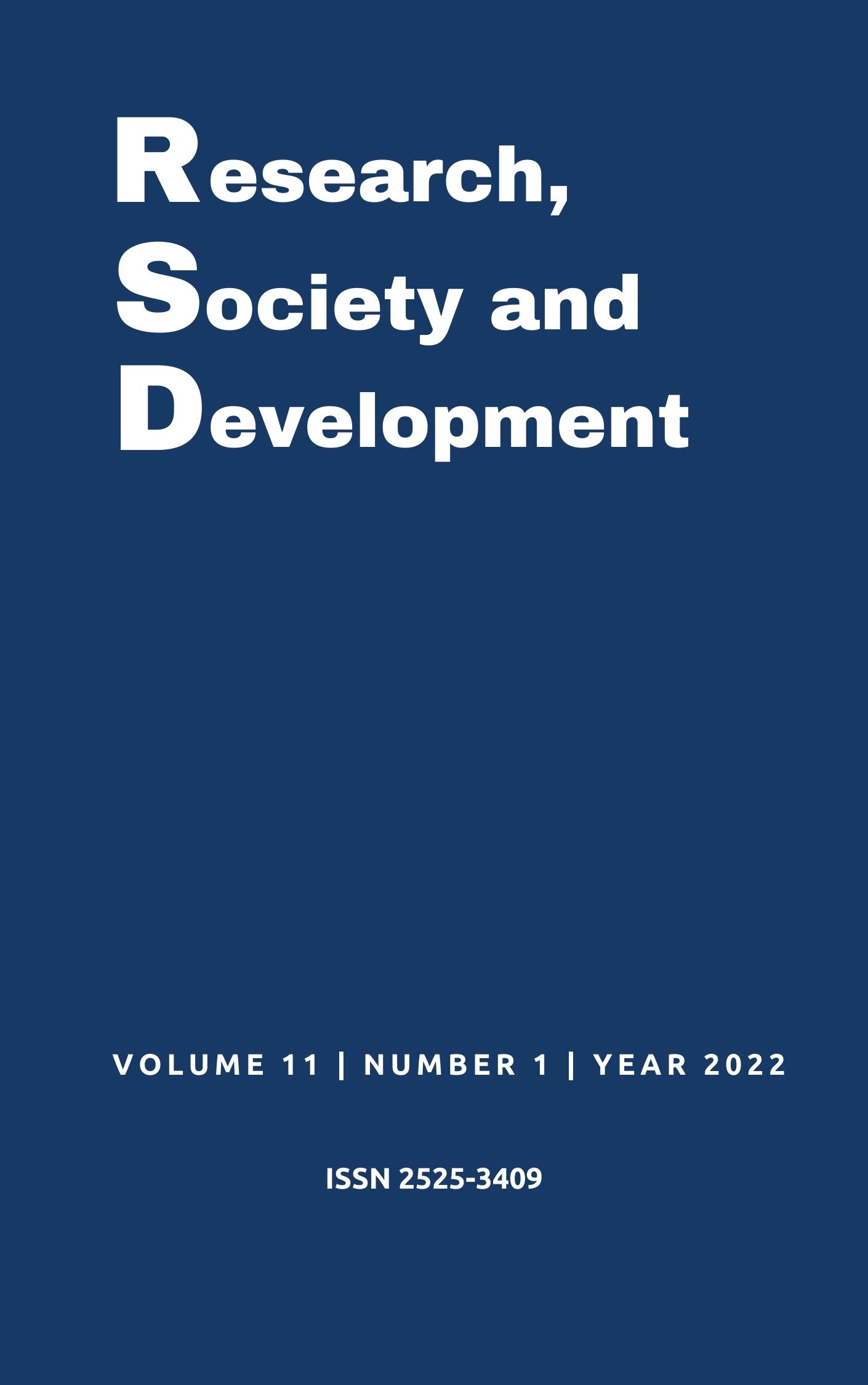Injerto de hueso alveolar secundario en fisura pre-forma incompleta: reporte de un caso
DOI:
https://doi.org/10.33448/rsd-v11i1.24969Palabras clave:
Paladar hendido; Injerto de hueso alveolar; Ortodoncia.Resumen
El labio leporino y el paladar hendido es una de las deformidades faciales más comunes. Durante la vida embrionaria, la no fusión de las placas nasales maxilar y medial conduce a labio leporino y paladar hendido. Las fisuras pueden producir una serie de problemas dentales en cuanto a número, tamaño, forma y posición, relacionados con la dentición temporal o permanente. Además, los dientes más afectados son los que se encuentran en la zona de la fisura. Existen numerosos protocolos de tratamiento, que, a pesar de la falta de consenso, parten del nacimiento del niño, llegando a la edad adulta, en busca de una rehabilitación funcional y estética. Las fases quirúrgicas, reparación de labios, reparación nasal, palatoplastia e injerto de hueso alveolar, se realizan según la edad. En cuanto al injerto óseo, la opción más utilizada es el injerto secundario, siendo el autógeno el más disponible. Así, el objetivo de este trabajo es presentar un caso clínico de injerto de hueso alveolar secundario en un paciente de 10 años con hendidura preforamen unilateral incompleta.
Citas
Alyami, B. et al. (2020). “Prevalence and Clinical Case Series of Syndromic and Nonsyndromic Cleft Lip and Palate in a Saudi Arabian Neonatal Population.” Cleft Palate-Craniofacial Journal 57(11): 1259–65.
Bergland, O., Gunvor, S., & Frank, E. A. (1986). “Elimination of the Residual Alveolar Cleft by Secondary Bone Grafting and Subsequent Orthodontic Treatment.” Cleft Palate Journal 23(3): 1–22.
Bittermann, Arnold J. N, Aebele B Mink Van De Molen, & Robert Jj. (2018). “Midfacial Growth and Dental Arch Relationships in Bilateral Cleft Palate Following Secondary Alveolar Bone Grafting and Orthodontic Intervention: Factors Predicting a Le Fort I Osteotomy at Age 18.” Journal of Cranio-Maxillo-Facial Surgery 46(10): 1764–71.
Brudnicki, A., Ewa Sawicka, R. B., & Piotr S. F. (2020). “Effects of Different Timing of Alveolar Bone Graft on Craniofacial Morphology in Unilateral Cleft Lip and Palate.” Cleft Palate-Craniofacial Journal 57(1): 105–13.
Coots, Br. K. (20120. “Alveolar Bone Grafting: Past, Present, and New Horizons.” Seminars in Plastic Surgery 26(4): 178–83.
Desai, A. K., et al. (2019). “Efficacy of Platelet-Rich Fibrin in Secondary Cleft Alveolar Bone Grafting.” Craniomaxillofac Trauma Reconstruction Open 3(1): e43–50.
Doucet, J C., et al. (2019). “Facial Growth of Patients With Complete Unilateral Cleft Lip and Palate Treated With Alveolar Bone Grafting at 6 Years.” Cleft Palate-Craniofacial Journal 56(5): 619–27.
Enemark, H., Steen S.-P., & Mette B. (1987). “Long-Term Results after Secondary Bone Grafting of Alveolar Clefts.” J Oral Maxillofac Surg 45(1): 913–18.
Farronato, G., et al. (2014). “How Various Surgical Protocols of the Unilateral Cleft Lip and Palate Influence the Facial Growth and Possible Orthodontic Problems? Which Is the Best Timing of Lip, Palate and Alveolus Repair? Literature Review.” Stomatologija 16(2): 53–60.
Huang, S., Yang C., and Zhenqi C. (2021). “Relationship Between Crown to Root Ratio and Alveolar Bone Support in Patients With Unilateral Cleft Lip and Alveolus.” Cleft Palate-Craniofacial Journal 58(2): 215–21.
Kassam, S. N. et al. (2020). “World Cleft Coalition International Treatment Program Standards.” Cleft Palate-Craniofacial Journal 57(10): 1171–81.
Kaura, A. S., Dhivya R. S., & Steven J. K. (2018). “Optimal Timing of Alveolar Cleft Bone Grafting for Maxillary Clefts in the Cleft Palate Population.” Journal of Craniofacial Surgery 29(6): 1551–57.
Lowry, C. H. et al. (2021). “The Effect of Earlier Bone Grafting, Prior to Orthodontic Treatment, on SWAG Ratings of Graft Outcomes.” Cleft Palate-Craniofacial Journal 58(2): 208–14.
Mahajan, R. et al. (2017). “Evaluation of Secondary and Late Secondary Alveolar Bone Grafting on 66 Unilateral Cleft Lip and Palate Patients.” Plastic Surgery 25(3): 194–99.
Mehta, S. et al. (2018). “Cost-Effectiveness Analysis of Demineralized Bone Matrix and RhBMP-2 versus Autologous Iliac Crest Bone Grafting in Alveolar Cleft Patients.” Plastic and Reconstructive Surgery 142(3): 737–43.
Mituuti, C. T., Silvia H. A. P-P, Giovana R. B., & Cristina G. de A. B-G. (2010). “Caracterização Da Fala de Indivíduos Submetidos à Palatoplastia Primária.” Revista da Sociedade Brasileira de Fonoaudiologia 15(3): 355–61.
Ralph Millard. (1980). III Plastic and Reconstructive Surgery Cleft Craft: The Evolution of Its Surgery—Volume III: Alveolar and Palatal Deformities.
Sancak, K, et al. (2019). “Effect of Alveolar Bone Grafting on Health Quality in Patients With Cleft Lip and Palate.” The Journal of craniofacial surgery 30(8): e771–74.
Scalzone, A., et al. (2019). “Secondary Alveolar Bone Grafting Using Autologous versus Alloplastic Material in the Treatment of Cleft Lip and Palate Patients: Systematic Review and Meta-Analysis.” Progress in Orthodontics 20(1).
Torres, A., et al. (2019). “A Programmable Expander for Patients with Cleft Lip and Palate.” Cleft Palate-Craniofacial Journal 56(6): 837–44.
Vellone, V., et al. (2017) “Canine Eruption after Secondary Alveolar Bone Graft in Unilateral Cleft Lip and Palate Patients.” Journal of Craniofacial Surgery 28(5): 1206–10.
Descargas
Publicado
Cómo citar
Número
Sección
Licencia
Derechos de autor 2022 Luiza Roberta Bin; Eleonor Álvaro Garbin Júnior; Geraldo Luiz Griza; Natasha Magro Érnica; Mauro Carlos Agner Busato; Ricardo Augusto Conci

Esta obra está bajo una licencia internacional Creative Commons Atribución 4.0.
Los autores que publican en esta revista concuerdan con los siguientes términos:
1) Los autores mantienen los derechos de autor y conceden a la revista el derecho de primera publicación, con el trabajo simultáneamente licenciado bajo la Licencia Creative Commons Attribution que permite el compartir el trabajo con reconocimiento de la autoría y publicación inicial en esta revista.
2) Los autores tienen autorización para asumir contratos adicionales por separado, para distribución no exclusiva de la versión del trabajo publicada en esta revista (por ejemplo, publicar en repositorio institucional o como capítulo de libro), con reconocimiento de autoría y publicación inicial en esta revista.
3) Los autores tienen permiso y son estimulados a publicar y distribuir su trabajo en línea (por ejemplo, en repositorios institucionales o en su página personal) a cualquier punto antes o durante el proceso editorial, ya que esto puede generar cambios productivos, así como aumentar el impacto y la cita del trabajo publicado.

